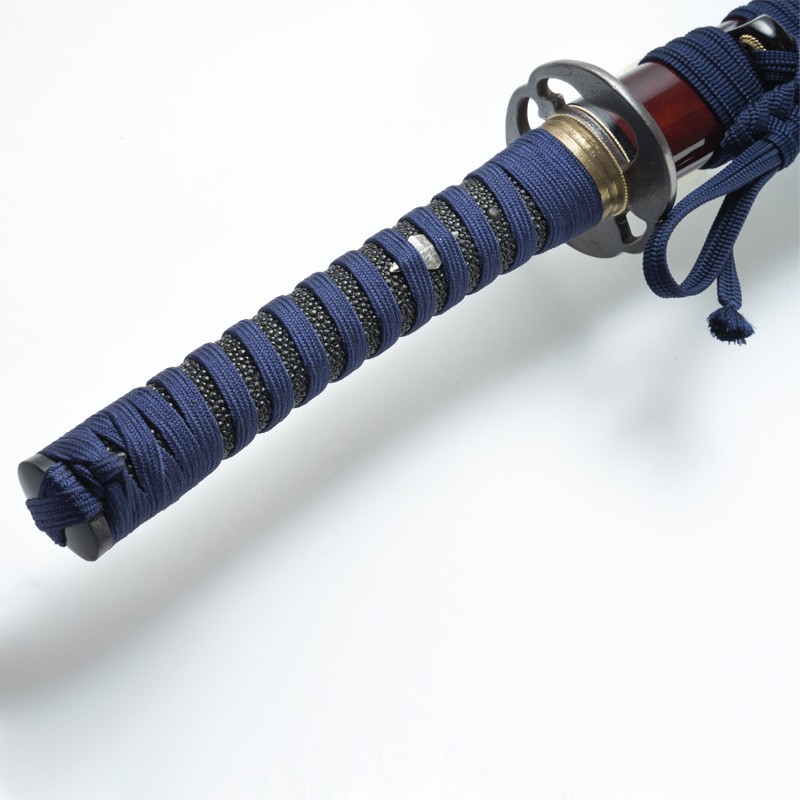














More informations about this product
The Akechi Koshirae 明智拵 mounting, is a mounting similar to Tensho Koshirae.
This high-end assembly will delight all aesthetes of Japanese art.
Its base, the Tensho montage, takes its name from the Tensho period 天正 (1573-1592), during the Azuchi Momoyama period. The name of this era was given by Oda Nobunaga and is inspired by a Chinese classic «Those who are at peace with Nature relate everything under the sky to its correct model» (清静者為天下正) ; Oda Nobunaga wanting to end the great wars of the lords of the Muromachi period and finally wishing to reunify Japan.
In contrast to the ostentatious montages of the Tachi of the Momoyama period, the Tensho Koshirae is historically the type of montage used for the Uchigatana, the ancestor of the current Katana. It was therefore equipped with simple and practical frames, with a black Same, a leather Tsuka ito, black metal or horn parts. The handle is Ryūgo (立拵 - hourglass-shaped), slightly curved (concave), giving it an easy grip. The Tsuka Ito is knotted in Makikake, over the Tsuka Kashira. Tsuba are simple, iron with openings (Sukashi) and often made by armor makers (Katchūshi).
This Akechi Koshirae montage takes its name from a Tensho montage owned by Akechi Mitsuharu (1537-1582), cousin of the famous Akechi Mitsuhide. Akechi Mitsuhide was the one who organized a surprise coup against Oda Nobunaga at the Honno-Ji in Kyoto in 1582 and forced the latter to make Seppuku (Ritual Suicide).
This Tensho Akechi Koshirae is originally made of leather Katate Maki, but it is presented here in Katate Maki with Blue Silk, over a full black tinted Samegawa.
The lacquer of the Saya is of type Urushi Tamenuri (or Shunkei) real. This Urushi lacquer, with shades of red-vermilion with variations in depth, is handmade and can never be identical. Tamenuri is the transparency effect given to this lacquer to have effects of depth and difference of colors absolutely splendid. These lacquers, sometimes composed of up to 20 layers, require 5 weeks to be made. It is a highly sought after craft work and appreciated in Japan. This type of Saya lacquer gives the Akechi Koshirae an unrivalled elegance compared to other iaito.
The blade type for this fixture is a light (standard) blade, approximately 820g.
Nagasa length possible from 2.20尺 (66.6cm) to 2.55尺 (77.3cm).
size charts (see attached table of recommended sizes)
Hamon: Suguha (straight line).
Habaki: Gold plated brass shonai, golden seppa.
Tsuba: Hyotan 瓢箪 (Calabash - Gourd) opening (Sukashi), symbol of luck and prosperity.
Fuchi/ Kashira: Black horn kashira, blackened silver fuchi.
Same: Same complete in Galuchat (Roussette or Raie), Black color.
Menuki: Hishi (菱 – Water Shiner, diamond), symbol of vitality and prosperity.
Tsukaito: Katate Maki Handle Braiding (Wrapped) in Navy Blue Top Silk.
Sageo: Real Navy Blue Silk.
Saya: Urushi Tamenuri Lacquer (Shunkei), Unique lacquer for each Saya, handmade, in carmine red (Urushi) shades on a black background with variations in depth.
The Minosaka Workshops :
The Iaito we offer come from Minosaka workshops in Gifu, Japan, and are manufactured in their workshop in Japan.
Gifu is one of the top places known for the forging of traditional sabres, including the Mino tradition, dating from the 14th century. Minosaka workshops are Iaito’s leading producers of tradition.
This traditional workshop manufactures its chrome-plated Zamak Iaito (Zinc and Aluminum alloy with some Copper) which is stainless.
This non-ferrous alloy makes the Iaito blunt and unsharpenable:
They are practical tools for Kata, without contact between the blades.
Share your opinion
error Your review appreciation cannot be sent
feedback Report comment
check_circle Report sent
error Your report cannot be sent